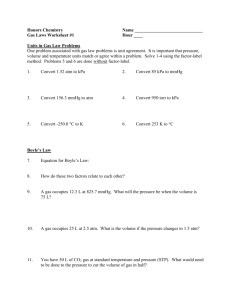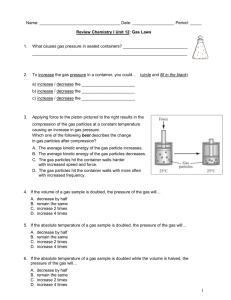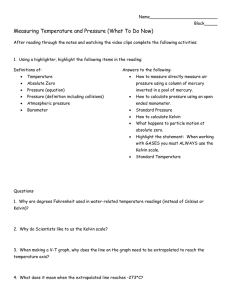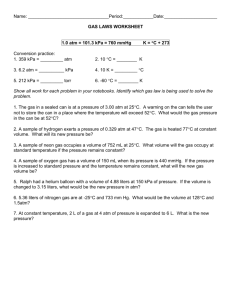3 basic gas laws
advertisement
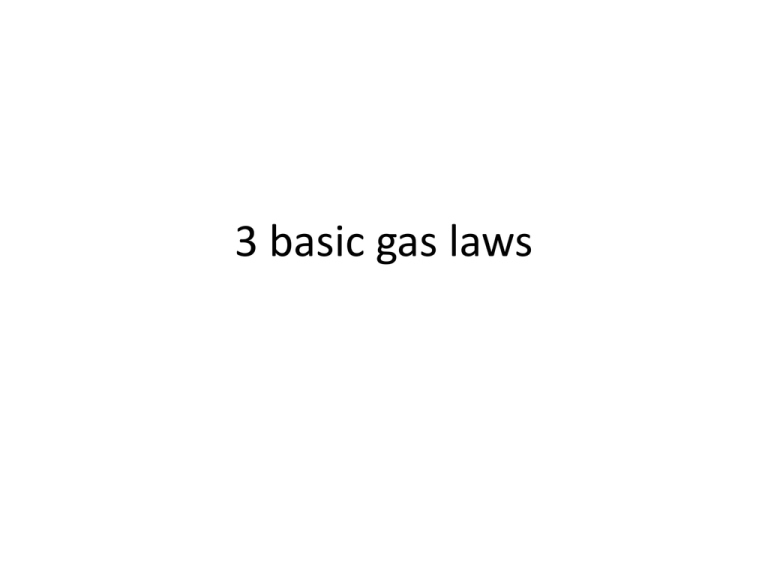
3 basic gas laws Definitions Volume – refers to the space matter (gas) occupies. Measured in liters (L). Pressure – the number of times particles collide with each other and the walls of the container (force exerted on a given area). Measured in atmospheres (atm). 1.000 atm = 760.0 millimeters Hg ( Barometers use Hg) 1.000 atm = 760.0 torr (Named after Torricelli for the invention of the barometer) 1.000 atm = 101.3 kPa – kilopascals Memorize Table 1. P. 542 *all have 4 sig dig STP: standard temperature and pressure (0°C, 101.3 kPa or 1atm). SATP: standard ambient temperature and pressure (25°C, 100 kPa). Sample Problems Convert 4.400 atm to mmHg. 1 atm = 4.40atm 760 mmHg x x = 3344 mmHg Convert 212.4kPa to mmHg. 101.3 kPa = 212.4 kPa 760 mmHg x x = 1594 mmHg Definitions Temperature – average kinetic energy as temperate increases gas particles move faster, as temperature decreases gas particles move slower. Measured in Kelvin (K). K = 273 + C Number of Moles – tells you how much of a certain gas you have 1 mole = number of grams of the compound or element (molar mass) Kelvin Practice What is the approximate temperature for absolute zero in degrees Celsius and kelvin? Absolute zero is – 273C or 0 K Calculate the missing temperatures 273 = _______ K 373 100C = _______ K – 173 100 K = _______ C 243 – 30C = _______ K 0C 27 300 K = _______ C 25C 298 = _______ K 403 K 130 = _______ C 0K – 273 = _______ C Boyle’s Law - Pressure and Volume (when temperature remains constant) V1P1 = V2P2 V1 = initial or old volume V2 = final or new volume P1 = initial or old pressure P2 = final or new pressure Inverse Relationship (As pressure increases, volume decreases and as pressure decreases, volume increases.) Effect of Pressure on Volume Boyle’s Law 1 atm 2 atm 5 atm 5 5 5 3 3 3 1 1 1 Which picture represents what the gas will look like when the pressure is doubled? (Assume constant n, T) Boyle’s Law P a 1/V P x V = constant P1 x V1 = P2 x V2 Constant temperature Constant amount of gas 5.3 Kinetic Molecular theory of gases and … • Boyle’s Law P a collision rate with wall Collision rate Increases with decreased volume P a 1/V Increase P, decrease volume An increase in pressure decreases the volume of air in the lungs. A sample of chlorine gas occupies a volume of 946 mL at a pressure of 726 mmHg. What is the pressure of the gas (in mmHg) if the volume is reduced at constant temperature to 154 mL? P1 x V1 = P2 x V2 P2 = P1 = 726 mmHg P2 = ? V1 = 946 mL V2 = 154 mL P1 x V1 V2 = 726 mmHg x 946 mL 154 mL = 4460 mmHg Sample Problems What is the new pressure when 80.0mL of gas at 500.mmHg is moved to a 100.mL container? (ans: 400. mmHg) A gas at 800.torr of pressure has a volume of 5.00L. What volume does this gas occupy at 1.00X103torr of pressure? (ans: 4.00 L) Charles’ Law -Volume and Temperature (when pressure is constant) V1/T1 = V2/T2 V1 = initial or old volume V2 = final or new volume T1 = initial or old temperature T2 = final or new temperature Direct Relationship (As temperature increases, volume increases and as temperature decreases, volume decreases.) The volume of a gas increases with and increase in temperature. How Volume Varies With Temperature If we place a balloon in liquid nitrogen it shrinks: So, gases shrink if cooled. Conversely, if we heat a gas it expands (as in a hot air balloon). Let’s take a closer look at temperature before we try to find the exact relationship of V vs. T. Which picture represents what the gas will look like when the temperature is increased? (Assume constant n, P) Kinetic theory of gases and … Charles’ Law -Average kinetic energy a T -Increase T, Gas Molecules hit walls with greater Force, this Increases the Pressure BUT since pressure must remain constant, and only volume can change -Volume Increase to reduce Pressure -Increase Temperature, Increase Volume A sample of carbon monoxide gas occupies 3.20 L at 125 0C. At what temperature will the gas occupy a volume of 1.54 L if the pressure remains constant? V1/T1 = V2/T2 T2 = V1 = 3.20 L V2 = 1.54 L T1 = 398.15 K T2 = ? V2 x T1 V1 = 1.54 L x 398.15 K 3.20 L = 192 K 2. A sample of gas occupies 3.5 L at 300 K. What volume will it occupy at 200 K? V1 = 3.5 L, T1 = 300K, V2 = ?, T2 = 200K Using Charles’ law: V1/T1 = V2/T2 3.5 L / 300 K = V2 / 200 K V2 = (3.5 L/300 K) x (200 K) = 2.3 L 3. If a 1 L balloon is heated from 22°C to 100°C, what will its new volume be? V1 = 1 L, T1 = 22°C = 295 K V2 = ?, T2 = 100 °C = 373 K V1/T1 = V2/T2, 1 L / 295 K = V2 / 373 K V2 = (1 L/295 K) x (373 K) = 1.26 L Gay-Lussac’s Law - Pressure and Temperature (when volume is constant) P1/T1 = P2/T2 P1 = initial or old pressure P2 = final or new pressure T1 = initial or old temperature T2 = final or new temperature Direct Relationship - As the temperature of the gas increases the pressure of the gas Increases. Sample Problems The gas in an aerosol can is at 3atm of pressure at 298K. What would the gas pressure in the can be at 325K? At 120.C the pressure of a sample of nitrogen gas is 769torr. What will the pressure be at 205C? The Combined Gas Law Combining the gas laws • So far we have seen three gas laws: Robert Boyle P1V1 = P2V2 Jacques Charles V1 = T1 V2 T2 These are all subsets of a more encompassing law: the combined gas law Joseph Louis Gay-Lussac P1 P2 = T1 T2 P1V1 P2V2 = T1 T2 Sample Problems A helium filled balloon has a volume of 50.0mL at 298K and 1.08atm. What volume will it have at 0.855atm and 203K? Given 700.mL of oxygen at 7.00C and 7.90atm of pressure, what volume does is occupy at 27.0C and 4.90atm of pressure? Note: any unit for pressure will work, provided the same units are used throughout. The only unit that MUST be used is K for temperature. • CW/ HW • Complete ISU booklet – 1st page • Practice questions on 1st 3 laws on 2nd page
